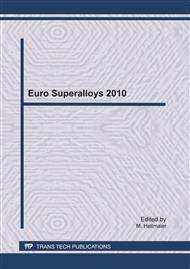[1]
F.R.N. Nabarro and H.L. De Villiers : The physics of creep, (Taylor & Francis, London 1995).
Google Scholar
[2]
M. Veron, Y. Brechet and F. Louchet: Acta Materialia, 44 (1996), p.3633.
Google Scholar
[3]
S. Dryepondt, D. Monceau, F. Crabos and E. Andrieu: Acta Materialia, 53 (2005), p.4199.
DOI: 10.1016/j.actamat.2005.05.018
Google Scholar
[4]
A. Raffaitin, D. Monceau, F. Crabos and E. Andrieu: Scripta Materialia, 56 (2007), p.277.
DOI: 10.1016/j.scriptamat.2006.10.026
Google Scholar
[5]
J. Cormier, X. Milhet and J. Mendez: Acta Materialia, 55 (2007), p.6250.
Google Scholar
[6]
F. Touratier, E. Andrieu, D. Poquillon and B. Viguier: Mater. Sci. and Eng., A 510-511 (2009), p.244.
Google Scholar
[7]
J. Cormier, X. Milhet and J. Mendez: Journal of Materials Science, 42 (2007), p.7780.
Google Scholar
[8]
C. Siret: PhD thesis, Institut National Polytechnique Université de Toulouse (2010).
Google Scholar
[9]
A. Epishin and T. Link: Philosophical Magazine, 84 (2004), p. (1979).
Google Scholar
[10]
P.M. Sarosi, R. Srinivasan, G.F. Eggeler, M.V. Nathal and M.J. Mills: Acta Materialia, 55 (2007), p.2509.
DOI: 10.1016/j.actamat.2006.11.045
Google Scholar
[11]
A. Kostka, G. Malzer, G. Eggeler, A. Dlouhy, S. Reese and T. Mack: Journal of Materials Science 42 (2007), p.3951.
Google Scholar
[12]
L.J. Carroll, Q. Feng and T.M. Pollock: Metallurgical and Materials Transactions A, 39 (2008), p.1290.
Google Scholar
[13]
F. Touratier: PhD thesis, Institut National Polytechnique, Université de Toulouse (2008).
Google Scholar
[14]
R. Srinivasan, G.F. Eggeler and M.J. Mills: Acta Materialia, 48 (2000), p.4867.
Google Scholar
[15]
A. Dlouhy, R. Schäublin and G. Eggeler: Scripta Materialia, 39 (1998), p.1325.
Google Scholar
[16]
T. Link, A. Epishin, M. Klaus, U. Brückner and A. Reznicek: Materials Science and Engineering: A, 405 (2005), p.254.
Google Scholar
[17]
B. Viguier, F. Touratier and E. Andrieu, (2010) to be published.
Google Scholar
[18]
F. Monpiou, L. Bresson, P. Cordier and D. Caillard: Philosophical Magazine, 83 (2003), p.3133.
Google Scholar
[19]
F. Mompiou and D. Caillard: Acta Materialia, 56 (2008), p.2262.
Google Scholar
[20]
F. Mompiou and D. Caillard: Materials Science and Engineering A, 483 - 484 (2008), p.143.
Google Scholar
[21]
D. Caillard and J.L. Martin : Thermally Activated Mechanisms in Crystal Plasticity (Elsevier, Oxford 2003).
Google Scholar
[22]
G. Dlubek, O. Brümmer and N. Meyendorf: Physica Status Solidi, 39 (1977), p. K95.
Google Scholar
[23]
H. Numakura, T. Ikeda, H. Nakajima and M. Koiwa: Materials Science and Engineering A, 312 (2001), p.109.
Google Scholar
[24]
X. Zhang and C. Y. Wang: Acta Materialia, 57 (2008), p.224.
Google Scholar
[25]
G.E. Murch and I.V. Belova: Journal of Materials Processing Technology, 118 (2001), p.82.
Google Scholar
[26]
E. Partyka and R. Kozubski: Intermetallics, 12 (2004), p.213.
Google Scholar


